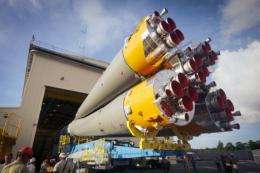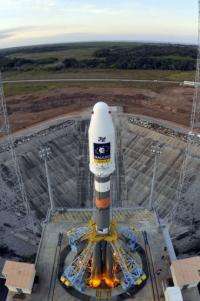Europe delays maiden launch of Soyuz with sat-nav payload

Europe announced a 24-hour delay in the maiden launch Thursday of a Russian rocket laden with the first satellites in a rival scheme to America's GPS geopositioning system.
The first launch of the legendary Soyuz from Europe's space base was scrubbed some two hours before lift-off after a problem developed in fuelling the rocket's third stage, Arianespace said.
"We are going to make a new attempt tomorrow at 7:30 a.m.," the launch operator's chief executive, Jean-Yves Le Gall, told a press conference.
The operation depends on replacing a defective valve and on the freshness of the launch crews after a 24-hour postponement, he said.
Carrying the first satellites in the Galileo system, Europe's 5.4-billion-euro (7.2-billion-dollar) answer to the US Global Positioning System (GPS), the Soyuz had been set for a 7:34 a.m. (1034 GMT) liftoff.

It is the first launch under a 2003 deal to deploy the rocket beyond the historic Soyuz bases in Plesetsk, northern Russia, and Baikonur, Kazakhstan.
The contract is designed to harvest revenue for Russia's space industry and add a medium-weight lifter to Arianespace's heavy Ariane 5 and a future lightweight rocket, the Vega.
Galileo is designed to comprise 27 operational satellites and three spares by its completion in 2020.
It should be accurate to within a metre (3.25 feet), whereas the GPS is currently accurate to between three and eight metres (10 and 26 feet), according to official websites.
Soyuz is built at the Samara space complex on the banks of the Volga. Its journey to Kourou is a weeks-long odyssey by train to St. Petersburg, by special freighter across the Atlantic and finally by truck from the port of Pariacabo, on the Kourou river.
The rocket ranks alongside the Saturn V, which took the Apollo astronauts to the Moon, as the most famous launcher in space history.
Its heritage can be traced to the dawn of the space race in 1957 with the launch of Sputnik and Yuri Gagarin's first manned flight in 1961. It is still being built at the rate of 15 to 20 rockets per year.
All told, its family has notched up 1,776 launches, with a success rate of more than 94 percent.
From Kourou, Soyuz will be able to hoist 2.8 tonnes into geostatieonary transfer orbit, compared with 1.7 tonnes from Baikonur. The difference is explained by the extra push given by Earth's rotation at the Equator.
(c) 2011 AFP



















